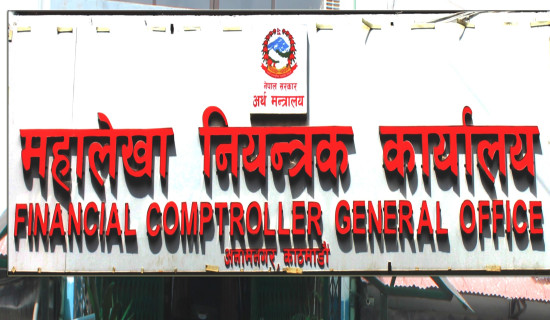- Tuesday, 16 December 2025
Indra Jatra: A Festival Of Unity And Delight
The grand celebration of Indra Jatra (Yenya Puni) begins with the ceremonial erection of the Indra Dhwaj (Indra's flag) in the enclosure of Hanuman Dhoka, Kathmandu. This moment, marked by the collective strength and wisdom of the community, signifies the formal commencement of the festival, filling the air with joy and excitement. The chariot procession then winds through the ancient streets of Kathmandu’s old city, passing through neighbourhoods such as Maru, Chikamuga, Jaisidewal, Lagan, Hyumat, and Bhimsensthan, as well as Pyafal, Yatkha, Ntyamaru Ajima, and Tyangal, before concluding at Kilagal. As the chariot makes its way, the faces of the local residents and onlookers are lit with a unique sense of delight and enthusiasm.
The formal start of Indra Jatra takes place at the Hanuman Dhoka Durbar courtyard in Indrapur. It is said that the image of Indra was set atop this temple during the Indra Jatra festival. Here, on the northern side, a sacred Yasinde pole, brought from Nala, Bhaktapur, is erected on the auspicious day of Bhadra Shukla Dwadashi, with the accompaniment of the Gurju platoon. The raising of this pole in the palace courtyard, accompanied by the sounds of traditional instruments like Dhimay, Khim, Dholak, Taa, Jhyali, Bhusya, and Khinpu, sets the stage for the dances of deities and marks the beginning of the festival.
National festival
Indra Jatra is a national festival of Nepal, deeply rooted in the Newar community, but one that attracts both local and international visitors. People are eager to capture the historical and traditional scenes of the festival on camera, savour the local delicacies like Samay Baji and enjoy the vibrant atmosphere. The ceremonial chariot procession is officially inaugurated by the Head of State, who offers blessings to the living goddess Kumari from the southern balcony of Gaddi Baithak in front of Kumari Ghar in Basantapur. On this day, residents eagerly await the arrival of the chariot, preparing either to offer prayers or to make arrangements for worship from the rooftops.
The festival is also an occasion for families to invite married daughters, friends, and relatives, offering feasts (Nakhatya) and gathering on balconies, windows, and courtyards to celebrate the chariot procession of Ganesh, Bhairav, and Kumari. The neighbourhoods resonate with the rhythmic dances of Mahakali and other deities, along with the lively performances of Lakhe and Pulu Kisi dances, adding to the festive atmosphere. Seeing the dances of deities in the middle of the streets can be surprising, especially to the younger generations, who often marvel at the idea that these places once served as public squares. The disappearance of such Dabalis (traditional Newar communal platforms) due to frequent earthquakes and road expansions has become a significant aspect of the festival's narrative.
In various localities, people gather in groups along the chariot’s route, playing instruments, dancing, and celebrating as they accompany the chariot, making the procession truly festive. Special highlights include the lively Pulu Kisi dance, the bright Dangi, Aju Dya, Sawa Bhakku, and the ceremonial distribution and consumption of Samay Baji. The tradition of consuming Hathu (local liquor) as a sacred offering at Hathu Dyah adds to the excitement and enjoyment. Gwara Mata: and Hyu Mata: is also lighted during this festival at Basantapur and Hyumat Tole respectively signifying this as festival of lights.
During the Indra Jatra festival, the deity Indra is referred to in Nepal Bhasa as “Khūndyah” and “Lūndyah.” On the day of Chatha, it is believed that Indra descended from heaven to earth to collect Chatha Swã (a special flower) for a ritual his mother was preparing in heaven. However, since he picked the flower without permission, he was accused of theft. In this context, the term “Khūndyah” denotes the event where Indra was bound as a thief, and “Lūndyah” stands for the golden idol of Indra that is displayed during the Indra Jatra festival.
Indra Jatra is celebrated in unique styles across various historical Newar settlements, including Kathmandu, Lalitpur, Bhaktapur, Dhulikhel and Dolakha. The festival involves the worship and adoration of Indra, the god of rain and good harvest, as well as the performance of various deity dances, Hathu Dyah worship, and the chariot procession of the living gods and goddesses. The legend of Indra being held captive for picking flowers without permission highlights the presence of Vedic deities in Newar worship practices. Though “Jatra” generally signifies a joyful festival, in the Newar community, the term can also imply a consequence, as seen in the expression “Timro Jatra Garnu Paryo” or in Nepal Bhasa “Changu Jatra ya mala la!” (You have to face your Jatra) when someone commits an unacceptable act.
Display of preserved artefacts
During the festival, the display of Indra, known as “Khūndyah” or “Lundyah” in Nepal Bhasa, and the golden statues of deities, can be seen as an early form of museum practice, showcasing preserved artefacts. Beyond the festival, the tradition of displaying statues and paintings, similar to the display of Bahi Deo Boye during Gunlā, serves not only as a religious and cultural activity but also as a method of preservation and protection.
The belief that the display of these objects in different seasons helps their natural preservation, such as the drying of grains, clothes, and other items in the sun and air during Bhadra month, is deeply rooted in local practices. This process is thought to ward off moisture and pests, believed to be carried by the winds from Gosaikunda.
The dances of deities on Dabalis during Indra Jatra, along with the performances of the Ten Incarnations (daśāvatāra) play, highlight the long-standing tradition of theatre in Newar culture. Overall, this festival serves as a grand celebration of traditional religious, social, and artistic practices within the Newar community, fostering unity and harmony in society which is never enough and forever joyous.
(The author is an officer at the Department of Archaeology.)
















